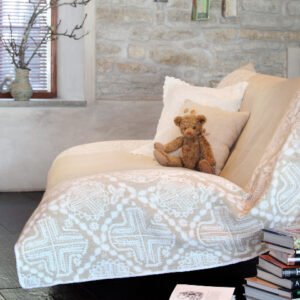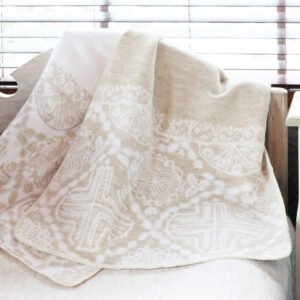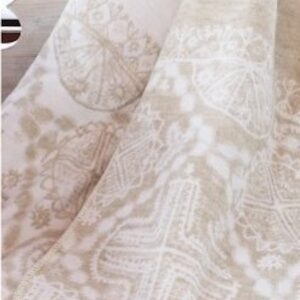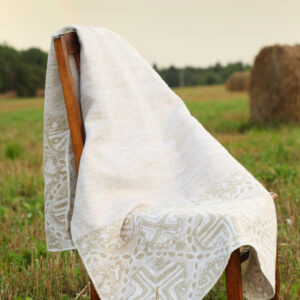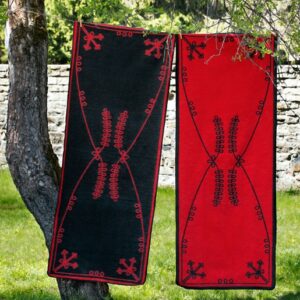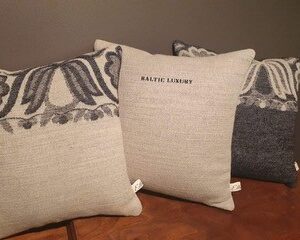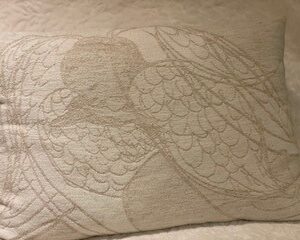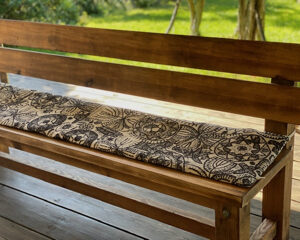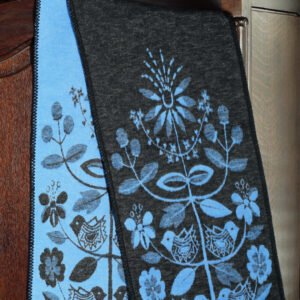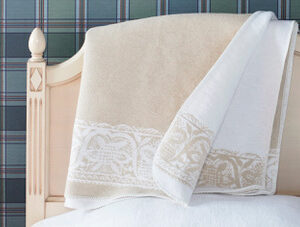+ Näita rohkem
-
Dimensions 145 x 200 cm 70% cotton, 30% flax In South Estonia, festive woollen rectangle wrap, worn across one’s shoulders, was the most respectable garment. In Paistu, even on the 19th century oblong woollen shawls were worn. White shawl was decorated by using archaic techniques and patterns that had a deep meaning. South Estonian scarf is inspired by Paistu apron, where cross (symbol of balance; possesses a protective meaning), circle (symbol of infinity, perfection and harmony) and thuja (symbol of conception and fertility) can be seen. Such shawls were only worn by adult women.
-
Dimensions 80 x 180 cm 70% cotton, 30% flax In South Estonia, festive woollen rectangle wrap, worn across one’s shoulders, was the most respectable garment. In Paistu, even on the 19th century oblong woollen shawls were worn. White shawl was decorated by using archaic techniques and patterns that had a deep meaning. South Estonian scarf is inspired by Paistu apron, where cross (symbol of balance; possesses a protective meaning), circle (symbol of infinity, perfection and harmony) and thuja (symbol of conception and fertility) can be seen. Such shawls were only worn by adult women.
-
Dimensions 60 x 180 cm 70% cotton, 30% flax In South Estonia, festive woollen rectangle wrap, worn across one’s shoulders, was the most respectable garment. In Paistu, even on the 19th century oblong woollen shawls were worn. White shawl was decorated by using archaic techniques and patterns that had a deep meaning. South Estonian scarf is inspired by Paistu apron, where cross (symbol of balance; possesses a protective meaning), circle (symbol of infinity, perfection and harmony) and thuja (symbol of conception and fertility) can be seen. Such shawls were only worn by adult women.
-
Dimensions 35x 180 cm 70% cotton, 30% flax In South Estonia, festive woollen rectangle wrap, worn across one’s shoulders, was the most respectable garment. In Paistu, even on the 19th century oblong woollen shawls were worn. White shawl was decorated by using archaic techniques and patterns that had a deep meaning. South Estonian scarf is inspired by Paistu apron, where cross (symbol of balance; possesses a protective meaning), circle (symbol of infinity, perfection and harmony) and thuja (symbol of conception and fertility) can be seen. Such shawls were only worn by adult women.
-
Dimensions 105 x 180 cm 70% cotton, 30% flax In South Estonia, festive woollen rectangle wrap, worn across one’s shoulders, was the most respectable garment. In Paistu, even on the 19th century oblong woollen shawls were worn. White shawl was decorated by using archaic techniques and patterns that had a deep meaning. South Estonian scarf is inspired by Paistu apron, where cross (symbol of balance; possesses a protective meaning), circle (symbol of infinity, perfection and harmony) and thuja (symbol of conception and fertility) can be seen. Such shawls were only worn by adult women.
-
Dimensions 110 x 180 cm 70% cotton, 30% flax In South Estonia, festive woollen rectangle wrap, worn across one’s shoulders, was the most respectable garment. In Paistu, even on the 19th century oblong woollen shawls were worn. White shawl was decorated by using archaic techniques and patterns that had a deep meaning. South Estonian scarf is inspired by Paistu apron, where cross (symbol of balance; possesses a protective meaning), circle (symbol of infinity, perfection and harmony) and thuja (symbol of conception and fertility) can be seen. Such shawls were only worn by adult women.
-
Dimensions 70 x 180 cm 100% cotton The creation of Mulgi scarf is inspired by the design of long coat from Mulgi region. Some older folks probably still remember coats made of such a strong fabric that it could be easily put upright and it would stand on its own. A coat was to last a whole lifetime of the owner, because not many could buy a new piece of clothing every year. Therefore a lot of work and effort was needed to create a woolen fabric so strong and thick that it would last such a long time. A piece of home-made woolen fabric was pre-shrunk to last longer. Soap and alkali (ash mixed with water) and sometimes a bit of brine for meat were used. After rinsing the pre-shrunk fabric with the substances needed, and bread was taken out of the oven, the fabric was left to dry for a few hours on thatch on top of the oven. Nowadays a coat similar to that is made from a much softer fabric. It was then colored to make a coat as black as the bark of alder. To be historically correct, the woolen long coat (Mulgi coat) was worn as a piece of clothing that was supposed to keep one warm and, if needed, to keep a fur coat on its place. It was considered to be a piece of festive clothing and one of the most important articles of one’s wardrobe. Fur coats were usually made of white sheepskin and our winters where sometimes muddy even during the old times. So the black coat was supposed to protect the rest of the clothing from splatters of dirt flying from underneath the sleigh shoes. Until the mid-19th century the outer garments for both women and men had the same cut. In the late 19th century shoulder seam was added. Women fastened their coat skirts with hooks placed under their breast; men did so by using a belt. Dark Mulgi coats are decorated with braids that even nowadays are handmade. While wearing something red around one’s neck or shoulders or on one’s coat, the red-colored yarn and braids were believed to possess protective powers. One will need 11 meters of braid for women’s clothing. Moreover, when making a statelier coat from Karksi, Tarvastu or Helme regions, one will need an impressive 30 meters. Of course it depends on how many loops one wants to use to create a beautiful pattern. These decorations would demonstrate the wealth of the owner. But this notion didn’t start before the second half of the 18th century when red decorative loops started appearing on southern coats. In some places they said that you could demonstrate your wealth this way – the richer the owner (wearer) the more braids on the coat. The motifs would be used repeatedly but some details as arches, lines and borders would differ. The pattern created almost a circle around the coat. Protective circles were believed to keep the wearer from bad words (or curses) and angry looks.
-
-
-
-
Size 70 x 200 What makes the Western Estonian shawl, traditionally called scarf, beautiful is its family tree motif that according to ancient traditions signifies happiness and the fulfilment wishes for a family. These are stories and patterns through which Ellu shawls celebrate a joyous occasion for our common home – the 100th independence day of the Republic of Estonia. The Western Estonian scarf draws its power and beauty from the family tree motif, widely cherished in Lääne County, the Western part of Estonia. This is the most widely used decoration for wedding blankets, however, its style varied from region to region. In the Lääne County, weavers used a special local technique and the tree was true to life and easily recognisable. On the island of Muhu , the wedding blankets woven at the end of the 19th century and the beginning of the 20th century were decorated using cross-stitching instead and the embroidery was very rich and expressive, fairy tale-like. The betrothed in Muhu embroidered motifs resembling trees into their blankets, decorated with multicolour leaves, songbirds, lush blooms and fruits. The hope was that these images would bring the family happiness and that all their wishes would come true. The artisans of that time especially favoured patterns featuring plants of various sorts, however, they also appreciated geometric lines. The tree motif can certainly be considered as the predecessor of the flower motif. To make sure even further that dreams would come true, the weavers decorated the top of the family tree with an octagram, a feature characteristic to Estonian folk patterns. Throughout history, the tree has been a widely used ornamental feature around the world. In handicraft arts, it has had powerful names such as the world tree, the tree of life and the tree of wishes. Estonians are a settled people that love their homeland, so this image has an additional significance – it reminds us of the ancient trees in the gardens of our farms and tells the tale of a heritage passed from generation to generation. Let this scarf and its family tree motif be a beautiful gift to all of us and remind us of what significant times we live in, and how important it is to protect our country and give each other gifts that bring good luck. The tradition of wearing shawls to cover shoulders goes back a long way. This shawl called scarf used to be considered the most valuable part of a traditional set of clothes, and it was mostly worn on special occasions. In cold weather, the scarf was worn to church or to go visit someone, but in warmer periods the scarf was worn looser, on the arms, to give a woman’s appearance that special celebratory note. Compared to other items of clothing, making a scarf required much more skill. Therefore, these shawls were cared for especially well and passed down from generation to generation, as were the skills used to make them.
-
Dimensions 145 x 180 cm 70% cotton, 30% flax In Pärnu County, wrap from fine wool and as big as blankets were thrown across one’s arm when going to church. This is where the name comes from – On-Arm Plaid. At large, the wrap was being worn across one’s shoulders. The characteristic of Estonian folk costumes is expressed in beautiful embroidery. Pärnumaa scarf has coif embroidery with original ornament where white woollen yarn is used.


